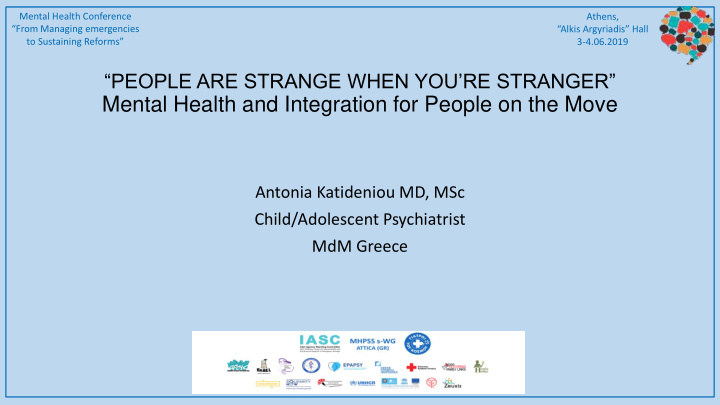



Mental Health Conference Athens, “From Managing emergencies “Alkis Argyriadis” Hall to Sustaining Reforms” 3-4.06.2019 “PEOPLE ARE STRANGE WHEN YOU’RE STRANGER” Mental Health and Integration for People on the Move Antonia Katideniou MD, MSc Child/Adolescent Psychiatrist MdM Greece
PEOPLE ON THE MOVE REFUGEE MINORS IN GREECE • A large number (30-40%) of migrants and refugees who have arrived in Greece since January 2015 are under 18 years old. A consistent number concerns unaccompanied minors.
Child-Adolescent mental health in the world Mental disorders affect children and youth from all socioeconomic and racial/ethnic backgrounds. No other illness damages so many children so seriously. Several factors predispose some children to greater risk for developing a mental disorder. Such factors are genetic predisposition, early years attachment , maturational environment, abuse, conflicts, war and poverty. • Up to 20% of children and adolescents worldwide suffer from a disabling mental illness (WHO, 2000). • S uicide is the 3rd leading cause of death among adolescents worldwide (WHO 2001). • Major depressive disorder (MDD) often has an onset in adolescence, across diverse countries and is associated with substantial psychosocial impairment and risk of suicide (Weissman 1999) • Conduct disorders tend to persist into adolescence and adult life and are frequently associated with delinquency, adult crime and dissocial behavior, marital problems, unemployment and poor physical health (Patterson. DeBaryshe, Ramsey, 1989)”.
MENTAL HEALTH DISORDERS OBSTACLE TO INTEGRATION Minors exposed to war and violence are at high risk of suffering from mental health problems. Behavioral and emotional problems- Aggression and other affective disorders- Anxiety- Depression Apart from war trauma, minor refugees Suffer from a trauma concerning chronic inappropriate living conditions. For example, unaccompanied adolescents mentioned poverty, lack of freedom and perspective as reasons of migration. Children with mental disorders were sick before the war, due to the lack of a mental health system. Women were depressed due to marriages without consent and gender based violence. 43% of children under five in low and middle income countries (LMIC) are at increased risk of developmental problems, according to Lanset series 2016 Pervasive developmental disorders
LACK OF COMPREHENSIVE MENTAL HEALTH SERVICES • The development of child-adolescent mental health services (CAMHS) is a necessity for each country, not only as a measure of prevention for the well-being of people but also as an investment in the future of countries. • The economic logic for CAMHS is simple: treating mental illness can be expensive, but leaving mental illness untreated is more expensive and many nations cannot afford it.
Service organization should be based on the principles of: • Availability • Accessibility • Acceptability • Integration • Sectorization • Continuity of care • Comprehensiveness • Evidence-based service • Respect for human rights World Health Organization 2003
Actions to reduce mental illness among children would produce major savings to society and the best way of DALYs reduction. DALYs = Disability Adjusted Life Years The sum of years of potential life lost due to premature mortality and the years of productive life lost due to disability.
MHPSS intervention • MHPSS interventions consist several interrelated activities with the explicit goal to improve the mental health and psychosocial well-being of refugees and other persons of concern.
INTEGRATION PROJECTS’ AIMS 1 Provision of psychosocial and mental health support/services for refugee and migrant children and their families 2 Improvement and increase of the access of refugee and migrant children to educational system (difficulties in integration and in extension mental health disorders is the lack of general education) 3 Access to Greek and English language, Educational aid 4 Access to secondary and tertiary health and mental health care services 5 Provision of non formal education (General Knowledge, Jobs Skills, creativity, socialization)
Child/adolescent Psychiatrists Psychologists Interdisciplinary teams Social workers Educational Aid (non formal, activities, school aid) operating in Day -Centers Interpreters Administrative staff
Diagnosis • Stress and Anxiety (Adjustment disorders) • Psychosomatic disorders • Dissociative [conversion] disorders • Post traumatic stress disorders • Contact Disorders • ADHD • Alcohol or other substance use disorders • Personality Disorders • Intellectual disability • Pervasive developmental disorders • Psychotic disorder • Depression
Factors influencing Psychopathology • Social exclusion of family • Low family-environmental education • No clear rules and limits posed • Living conditions • Personality-temperament • Family psychiatric history • Degree of severity of trauma
More actions to be undertaken – Parents /Family empowerment – Improvement of living conditions – Access to education – Community interventions Staff interventions – Clinical meetings – Training – Supervision
CHALLENGES • Uncooperative Families/Teens (not used to mental health aid, stigma) • Non-collaborative frameworks (NGOs, Hospitals, Social Services) • Discontinuous Projects/Lack of funding • Weakness of institutional framework • Lack of support for professionals/ bad working conditions/ education/ supervision
Thanks for your attention
Recommend
More recommend